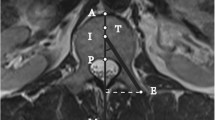Abstract
Objective
To investigate the accuracy, procedure time, fluoroscopy time, and dose area product (DAP) of needle placement during percutaneous vertebroplasty (PVP) using cone-beam computed tomography (CBCT) guidance versus fluoroscopy.
Materials and Methods
On 4 spine phantoms with 11 vertebrae (Th7–L5), 4 interventional radiologists (2 experienced with CBCT guidance and two inexperienced) punctured all vertebrae in a bipedicular fashion. Each side was randomization to either CBCT guidance or fluoroscopy. CBCT guidance is a sophisticated needle guidance technique using CBCT, navigation software, and real-time fluoroscopy. The placement of the needle had to be to a specific target point. After the procedure, CBCT was performed to determine the accuracy, procedure time, fluoroscopy time, and DAP. Analysis of the difference between methods and experience level was performed.
Results
Mean accuracy using CBCT guidance (2.61 mm) was significantly better compared with fluoroscopy (5.86 mm) (p < 0.0001). Procedure time was in favor of fluoroscopy (7.39 vs. 10.13 min; p = 0.001). Fluoroscopy time during CBCT guidance was lower, but this difference is not significant (71.3 vs. 95.8 s; p = 0.056). DAP values for CBCT guidance and fluoroscopy were 514 and 174 mGy cm2, respectively (p < 0.0001). There was a significant difference in favor of experienced CBCT guidance users regarding accuracy for both methods, procedure time of CBCT guidance, and added DAP values for fluoroscopy.
Conclusion
CBCT guidance allows users to perform PVP more accurately at the cost of higher patient dose and longer procedure time. Because procedural complications (e.g., cement leakage) are related to the accuracy of the needle placement, improvements in accuracy are clinically relevant. Training in CBCT guidance is essential to achieve greater accuracy and decrease procedure time/dose values.





Similar content being viewed by others
References
Voormolen MH, Mali WP, Lohle PN et al (2007) Percutaneous vertebroplasty compared with optimal pain medication treatment: short-term clinical outcome of patients with subacute or chronic painful osteoporotic vertebral compression fractures. The VERTOS study. Am J Neuroradiol 28(3):555–560
Jarvik JG, Hollingworth W (2007) VERTOS: a step in the right direction. Am J Neuroradiol 28(3):561–562
Klazen CA, Verhaar HJ, Lampmann LE (2007) VERTOS II: percutaneous vertebroplasty versus conservative therapy in patients with painful osteoporotic vertebral compression fractures: rationale, objectives and design of a multicenter randomized controlled trial. Trials 8:33
Predey TA, Sewall LE, Smith SJ (2002) Percutaneous vertebroplasty: new treatment for vertebral compression fractures. Am Fam Physician 66(4):611–615
Venmans A, Lohle PN, van Rooij WJ et al (2008) Frequency and outcome of pulmonary polymethylmethacrylate embolism during percutaneous vertebroplasty. Am J Neuroradiol 29(10):1983–1985
Racadio JM, Babic R, Homan R et al (2007) Live 3D guidance in the interventional radiology suite. Am J Roentgenol 189:W357–W364
Braak SJ, van Strijen MJL, van Leersum M et al (2010) Real-time 3D fluoroscopy guidance during needle interventions: technique, accuracy, and feasibility. Am J Roentgenol 194(5):W445–W451
Hiwatashi A, Yoshiura T, Noguchi T et al (2008) Usefulness of cone-beam CT before and after percutaneous vertebroplasty. Am J Roentgenol 191(5):1401–1405
Powell MF, DiNobile D, Reddy AS (2010) C-arm fluoroscopic cone beam CT for guidance of minimally invasive spine interventions. Pain Physician 13(1):51–59
Pedicelli A, Rollo M, Piano M et al (2009) Percutaneous vertebroplasty with a high-quality rotational angiographic unit. Eur J Radiol 69(2):289–295
Tenjin H, Mandai A, Umebayashi D et al (2009) Percutaneous vertebroplasty under three-dimensional radiography guidance. Technical note. Neurol Med Chir (Tokyo) 49(4):179–183
Maeda N, Osuga K, Higashihara H et al (2008) A novel cone-beam CT guided intervention by XperGuide: accuracy and feasibility in a phantom model [abstract no. 237]. J Vasc Interv Radiol 19(2):S90
Tam AL, Mohamed A, Pfister M et al (2010) C-arm cone beam computed tomography needle path overlay for fluoroscopic guided vertebroplasty. Spine 35(10):1095–1099
Miller DL, Balter S, Cole PE et al (2003) Radiation doses in interventional radiology procedures: the RAD-IR study: Part I: overall measures of dose. J Vasc Interv Radiol 14(6):711–727
Luchs JS, Rosioreanu A, Gregorius D et al (2005) Radiation safety during spine interventions. J Vasc Interv Radiol 16:107–111
Hoheisel M, Skalej M, Beuing O et al (2009) Kyphoplasty interventions using a navigation system and C-arm CT data: first clinical results. Med Imaging Phys Med Imaging 7258:E1–E8
Becker HC, Meissner O, Waggershauser T (2009) C-arm CT-guided 3D navigation of percutaneous interventions. Radiologe 49(9):852–855
Limthongkul W, Karaikovic EE, Savage JW et al (2010) Volumetric analysis of thoracic and lumbar vertebral bodies. Spine J 10(2):153–158
Liebschner MA, Rosenberg WS, Keaveny TM (2001) Effects of bone cement volume and distribution on vertebral stiffness after vertebroplasty. Spine 26(14):1547–1554
Beck M, Mittlmeier T, Gierer P et al (2010) Intraoperative position determination of bone cement trocars by 3-dimensional imaging in patients with osteoporotic vertebral fractures. J Spinal Disord Tech 23(7):E16–E23
Conflict of interest
Sicco J. Braak, Kirsten Zuurmond, Hans C. J. Aerts, Marc van Leersum, Timotheus T. Th Overtoom, Johannes P. M. van Heesewijk, Marco J. L. van Strijen have no conflict of interest
Author information
Authors and Affiliations
Corresponding author
Rights and permissions
About this article
Cite this article
Braak, S.J., Zuurmond, K., Aerts, H.C.J. et al. Feasibility Study of Needle Placement in Percutaneous Vertebroplasty: Cone-Beam Computed Tomography Guidance Versus Conventional Fluoroscopy. Cardiovasc Intervent Radiol 36, 1120–1126 (2013). https://doi.org/10.1007/s00270-013-0598-y
Received:
Accepted:
Published:
Issue Date:
DOI: https://doi.org/10.1007/s00270-013-0598-y




